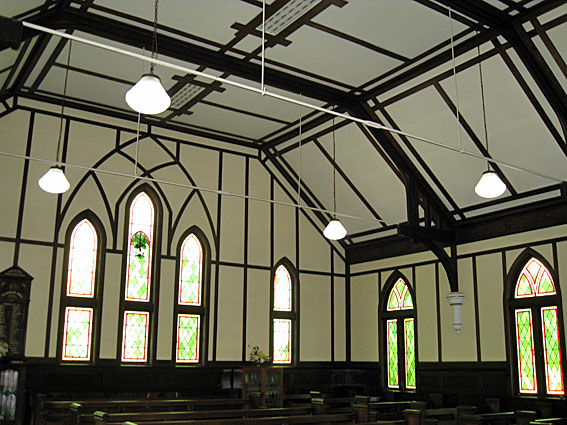
St John’s Presbyterian Church, Annerley
[Photograph by Geoffrey Cox (July 2011)]

St John’s Presbyterian Church, Annerley
[Photograph by Geoffrey Cox (July 2011)]
Historical and Technical Documentation by Geoffrey Cox
© OHTA 2011, 2014 (last updated June 2014)
The first Presbyterian church at Thompson Estate (now part of Annerley) was opened in May 1886, stemming from the longer established congregation of the Park Presbyterian Church in South Brisbane. The present church was built during the incumbency of the Scottish-born Rev. Alexander Duff (1885-1973),1 and was officially opened and dedicated on Saturday 23 November 1929.
The exterior of the building is of timber and rough-cast asbestos sheeting, surmounted by a turret. The interior features attractive oak paneling around the walls, with asbestos sheeting in panel effect on the upper walls and ceiling, all lit by leadlight casement windows. The architect was Mr George Trotter of Annerley, a member of the congregation.2


Interior paneling (1929) and organ (1930)
at St John’s Presbyterian Church, Annerley
[Photographs by Geoffrey Cox (July 2011)]
A recess for the pipe organ was provided in the design of the building. The organ was built by Whitehouse Bros at a cost of £572.7.0,3 and opened on Sunday 15 June 1930. A newspaper notice on the previous day also announced an organ recital to be given on the following Thursday:
PRESBYTERIAN
The Rev. John Sinclair, of St. Paul's, will conduct the dedicatory service at the opening of the new pipe organ at St. John's to-morrow morning. An organ recital will be given on Thursday evening next, when Mr. Robert Kaye will be the organist.4
The organist of the church at the time the organ was installed (and earlier) was Mr James Priest, who served in this role for 40 years:

Plaque recording James Priest’s 40 years as organist
[Photograph by Geoffrey Cox (July 2011)]
This instrument was one of the standard small two-manual Whitehouse pneumatic-action organs of the time, the specifications of which varied little over four decades from c.1910 onwards. Along with the organ at Holy Trinity Anglican Church, Woolloongabba, it was one of the first to include the duplexing of the Swell string stop on the Great under the name "Salicional".5 The stop-keys are of the inclined-block type, two of which, as shown below, do not bear pitch indications.

Console of the Whitehouse Bros organ
[Photograph by Geoffrey Cox (July 2011)]

The Whitehouse Bros organ, c.1950
[Photograph from the Scrapbooks of Miss Margery Horn]
The organ was cleaned and overhauled in 1940, and two stops were added in 1945 (Great Flute 8ft at a cost of £90) and 1948 (Swell Oboe 8ft at a cost of £216.10.0) by Whitehouse Bros.6
| GREAT Open Diapason Salicional Flute SWELL Violin Diapason Echo Gamba Lieblich Gedact Harmonic Flute Oboe PEDAL Bourdon COUPLERS Swell Octave to Great Swell Sub to Great Swell to Great Swell to Pedal Great to Pedal |
8 8 8 8 [8] 8 [4] 8 16 |
A A |
[1945] [stpd bass] [1948] |
[Swell] tremulant
Balanced swell pedal
Compass: 61/30
Pedalboard: radiating & concave
Attached roll-top console
Tubular-pneumatic action. 7



Stop-keys and builder’s plate
[Photographs by Geoffrey Cox (July 2011)]
___________________________________________________________________________
1 Richard Bardon, The Centenary History of the Presbyterian Church of Queensland, 1849-1949 (Brisbane: W. R. Smith & Paterson, 1949), p. 213.
2 The Brisbane Courier (25 November 1929), p. 14; St. John's Presbyterian Church, Thompson Estate, Brisbane: Jubilee souvenir 1885-1935, p. 19.
3 Whitehouse Bros Ledger (1922-1940), p. 450.
4 The Brisbane Courier (14 June 1930), p. 10; see also The Brisbane Courier (19 June 1930), p. 22, and The Brisbane Courier (21 June 1930), p. 12.
5 Here and at Holy Trinity, Woolloongabba, the Swell string stop was named "Echo Gamba", whereas it was named "Gamba" at Eagle Junction Congregational Church and others in the mid 1930s and later. Earlier instruments of similar size, such as those at St Francis, Nundah (1926) and St Barnabas, Ithaca (1913), had generally included an independent "Dulciana" on the Great. The duplexing arrangement can be observed much later at Morningside Methodist Church (1947) and Lutwyche Methodist Church (1949), although both stops were named "Salicional" by this time.
6 Whitehouse Bros Ledger (1922-1940), p. 522; Whitehouse Bros Ledger (1940-1954), pp. 342-43.
7 Specification noted by G. Cox, 1973 and 2006.